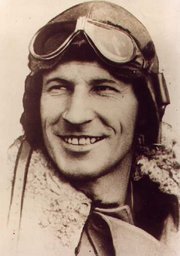Charles Kingsford Smith
|
|
Air Commodore Sir Charles Edward Kingsford Smith MC, (February 9, 1897 - November, 1935), often called Charles Kingsford-Smith, or by his nickname Smithy, was the best-known early Australian pioneer aviator. He completed the first non-stop crossing of the Australian mainland and the first flight from Australia to New Zealand, and was also the first to complete the more difficult eastward Pacific crossing from Australia to the United States, in 1934.
Kingsford Smith was born in Brisbane, Queensland, Australia, and was one of seven children. From 1905 to 1909, he and his family lived in Vancouver, British Columbia, Canada. Upon returning to Australia, he attended St Andrew's Cathedral School in Sydney where he was a treble chorister in the cathedral choir. He then studied electrical engineering at Sydney Technical College (now known as Sydney Technical High School). He was reportedly expelled from this school. At 16 he became an engineering apprentice with the Colonial Sugar Refining Company. After that, he enlisted for duty in the armed services in 1915 and served at Gallipoli. Initially, he performed duty as a motorcycle despatch rider, before transferring to the Royal Flying Corps, earning his wings in 1917. For his services in battle, he was awarded the Military Cross.
On May 31, 1928, Kingsford Smith and his crew left the United States to make the first Trans-Pacific flight to Australia in the Southern Cross, a Fokker FVII-3M monoplane. The flight was in three stages, from Oakland, California to Hawaii, then to Suva, Fiji, and on to Brisbane, where he landed on June 8. On arrival, he was met by a huge crowd at Eagle Farm Airport, and was feted as a hero. Australian aviator Charles Ulm was the relief pilot, and the other two crew members were Americans James Warner and Captain Harry Lyon (who were the radio operator, navigator and engineer for the trans-Pacific flight). The Australian film "Smithy" is based on Charles Kingsford Smith and his historic epic flight across the Pacific.
In 1930, he competed in an England to Australia air race, and, flying solo, won the event.
It was during another epic flight that Kingsford Smith met his end. Once again flying from England to Australia, he and his copilot departed Allahabad, India for a leg to Singapore, flying in Lockheed Altair Lady Southern Cross. The aircraft did not arrive at its destination. Eighteen months later, wreckage from the aircraft was located off the south coast of Burma. The remains of the crew have never been located.
The major airport of Sydney, located in the suburb of Mascot was named Kingsford Smith International Airport in his honour. A federal electorate, for the federal parliament of Australia, which encompasses the airport is called Kingsford Smith. His aircraft, the Southern Cross, is now preserved and displayed in a purpose built memorial at the International Terminal at Brisbane Airport. Kingsford Smith Drive in Brisbane passes through the suburb of his birth, Hamilton. He was also pictured on the Australian $20 paper note (in circulation from 1966 until 1994, when the $20 polymer note was introduced to replace it) to honour his contribution to aviation and his accomplishments during his life.
Kingsford-Smith was knighted in 1932 for services to aviation and later was appointed honorary Air Commodore of the Royal Australian Air Force.
External links
- Charles Kingsford Smith The Pioneers - Aviation and Aeromodelling (http://www.ctie.monash.edu.au/hargrave/k-smith.html) -
- Charles Kingsford Smith biography Ace Pilots (http://acepilots.com/wwi/pio_ksmith.html) -
- Sir Charles Kingsford Smith Australian Heroes (http://www.diggerhistory.info/pages-heroes/k-smith-mc.htm) -
- Charles Kingsford Smith ABC website (http://www.abc.net.au/btn/australians/cksmith.htm) -
- Charles Kingsford Smith about the Tasman flight (http://www.airborne.org/flying/smithy.htm) -
- Charles Kingsford Smith (includes photos of Sir Charles Kingsford Smith and his aeroplane, the Southern Cross) (http://www.airborne.org/flying/smithy2.htm) -
- Sir Charles Kingsford Smith Sound Recordings and Newsreels (http://www.screensound.gov.au/screensound/screenso.nsf/allDocs/RWP6B6F10B0FC63D1F1CA256CE70078D7F7?OpenDocument) -
- Austin Byrne and the Kingsford Smith Southern Cross Memoria Memorial (http://nla.gov.au/nla.pic-an14514137)

